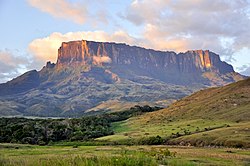Table (landform)
A table (landform) is a high rock structure with a flat top. There are many different terms for this landform feature.



The tuya is a structure formed by a subglacial (under ice) volcano. Lava erupts underneath an overlying glacier or ice sheet. It melts through to the surface and pools, producing the flat plateau on top with near-vertical walls along the ice-contact margin as the lava cools and hardens.
A similar landform is the tepui, which has a rather different origin. A body of hard rock resists erosion. It was originally inside a body of softer rock such as limestone, which got eroded away to form a plain. The more resistant rock is left behind as an isolated mountain. The term is used for the table-top mountains of South America. Auyán-tepui in the Guiana Highlands, Venezuela is the source of the Angel Falls, the tallest waterfall in the world.[1] It is 19 times higher than Niagara Falls.
- Tuya
- Tepui
- Mesa
- Potrero
- Butte
- Plateau
- Terrace
- Table
- Table hill
- Table-topped hill
- Table mountain
- Tableland
Table Mountain in South Africa is the best-known example of a table landform.
References
change- ↑ Brewer-Carías C. 2010. Tras la huella: del Salto Angel. Río Verde 2: 61–77.